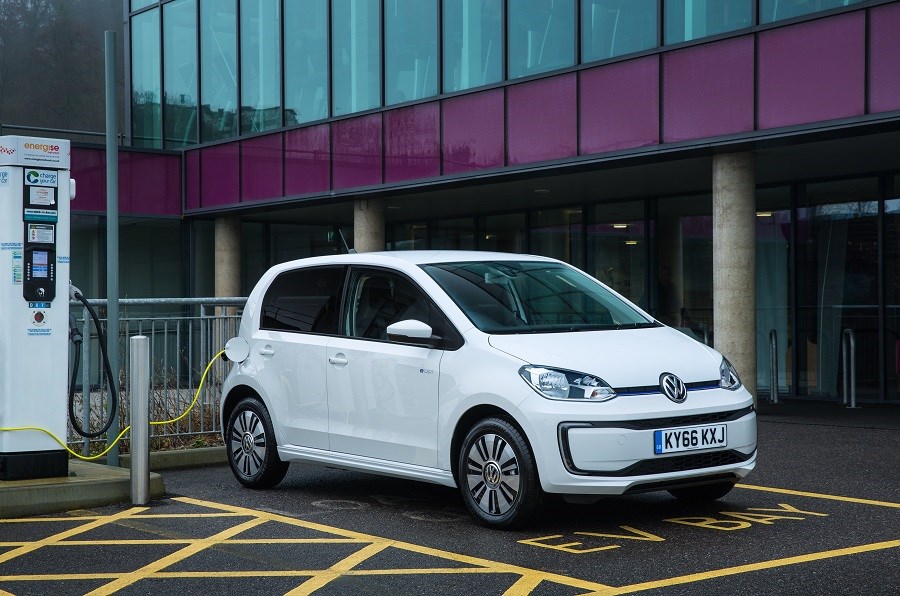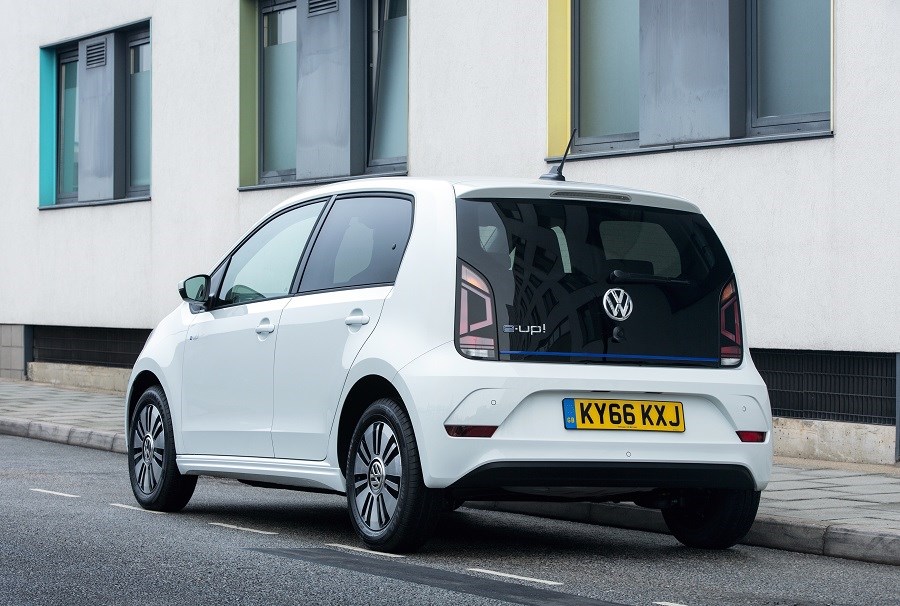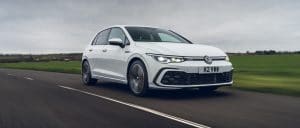Model review
The Volkswagen Up! is a quirky city car that has proven to be a big hit since it first went on sale in 2012.
The Up! is built alongside both the Skoda Citigo and Seat Mii at the VW Group’s assembly plant in Bratislava, Slovakia.
It made sense for VW’s first fully-electric offering to be a version of its smallest city car, which is why an electric version of the Up!—the appropriately named e-Up!—went on sale at the end of 2013. Unlike the rest of the Up! range, the e-Up! is available only as a five-door, with seating for four people.
Latest Model
Aside from it receiving a light facelift along with the standard Up! in 2016, the e-Up! has seen very little development since launch.
The only differentiators between pre and post-facelift versions are a lightly re-designed rear bumper and front lights, plus some additional colours to choose from.
As of March 2019, the e-Up! had been temporarily removed from sales, with long waiting times being given as the reason for the postponement of orders.
Value for money
The e-Up! is pricey for what it is, and for most people, justifying the purchase of the electric version over its petrol counterpart is incredibly difficult—particularly on the new market. Even with the government’s electric car grant, you are looking at spending almost double what you would for a base petrol engine. It does come with plenty of kit for the money, including parking sensors, cruise control, satellite navigation and heated seats.
Despite experts predicting that the e-Up! would hold onto its value terribly, it has actually depreciated nowhere near as badly as predicted. We saw a 2014 example for sale with 6,000 miles on the clock for £12,995, which is still at least £5,000 more than you would be paying for a top-of-the-range petrol-engined Up!.
Initial depreciation will hit hard, though, as one-year-old examples can be found with £5,000 shaved off the initial asking price—or nearly £10,000 if you include the electric car grant.
Due to the fact that it has sold relatively slowly, there are only a few available on the used market, which does make it quite difficult to gauge values on.
Looks and image
The standard Up! is a funky looking city car anyway, and the slight adjustments made to its styling for the e-Up! only make it look better. Of the changes, the most notable is the LED daytime running lights that outline the grille. The interior is also pleasant, with a user-friendly layout. However, it is barely altered over the regular Up!, which does make the high list price quite hard to swallow.
Some of the charm of the Up! has also been lost thanks to the increased weight from the batteries. A hefty 200kg has been added, which is a lot of extra weight on a car of this size. Despite this, the e-Up! remains fairly nimble in corners and feels fast enough for you not to notice the extra ballast most of the time. It’s also a lot more enjoyable to drive than other EVs such as the Renault Zoe.
The main difference that drivers of the petrol Up! will notice when switching to the electric version is the regenerative braking system, which charges the car’s batteries when slowing down by applying the brakes as soon as you lift off the throttle. While it does sound a little bit complex, it is easy to get used to, and you ultimately discover a smoother driving experience, since you have to physically brake less.
The lack of background drone also means that the e-Up! is nearly silent to drive; the only sound you hear is the background wind and road noise. The engineers have done a good job of insulating the cabin from it, though.
Space and practicality
Unlike other electric cars, the e-Up! is just as practical as the petrol version, with the same interior and boot space.
Unfortunately, the Up! is designed to be a small city car, which means that it’s not all that practical anyway. While it’s fine for city dwellers, it really is a bit small to use as a family car. The e-Up! is therefore best kept as a second car unless you rarely carry rear passengers.
The Up! is a strict four-seater, and you’ll really struggle to get any tall adults in the back. Plus, if you do, it certainly won’t be very comfortable. The boot offers 251 litres of capacity, which is actually quite impressive for such a compact car; it is considerably more than what rivals such as the Citroen C1 (168 litres) offer.
Euro NCAP awarded the Up! a full five stars in its safety tests, and the performance of the e-Up! shouldn’t be any different. The safety kit included as standard is impressive, with electronic stability control, autonomous emergency braking and Isofix child-seat mounts all present and correct.
Power and range
The e-Up! is powered by a 60kW electric motor that produces 81bhp and 210NM of torque. It takes a lengthy 12.2 seconds to get up to 60mph, although the way the electric motor delivers its performance does make it seem a little bit quicker than these figures would suggest.
The e-Up! delivers a claimed 99-mile range, although under heavy acceleration you won’t get anywhere near this figure. Because of the smaller batteries fitted to the e-Up!, it does not take quite as long to charge as its rivals, although this does mean a compromise on range. It takes nine hours to charge using a domestic plug socket, but it can be charged in just 30 minutes using a rapid charger.
Running costs
The petrol Up! isn’t exactly an expensive car to run, but the e-Up! will be even cheaper. It is road tax exempt, which also means that you won’t have to pay the London Congestion Charge and other emissions-based road charges around the UK.
It also occupies the lowest company-car tax band, meaning it could halve your company car costs compared to a typical petrol-engined city car, and provide a significant reduction to the business tax you pay each month, too.
While the range of the VW e-Up! isn’t all that impressive at 99 miles, it should easily be enough for city dwellers that have regular access to an electric charger. The cost to charge up will also be much less than petrol or diesel, which should mean significant savings in this area, too.
The e-Up! is placed in insurance group 10, which is quite high compared to the base-level 74bhp petrol version. The 89bhp 1.0-litre turbocharged petrol version of the standard Up! is also ranked in group 10, which does mean that it and the e-Up! are both out of reach to first drivers from an insurance perspective.
Things to look for
Volkswagen has a reasonably good reputation for reliability and owners have reported few faults with the Up! since it first went on sale in 2012. The e-Up! should be no different, and is covered by VW’s three-year warranty, too. The batteries are covered for eight years or 100,000 miles, which is further peace of mind for e-Up! owners.
Rivals
The closest rival is the Renault Zoe, which is bigger, cheaper and offers a greater range. It certainly doesn’t have the build quality to match the e-Up!, though. Other rivals include a nearly-new Nissan Leaf, the Volkswagen e-Golf and the BMW i3. If you are looking at the e-Up!, it’s also worth looking at a top-spec petrol-engined Up! to see if you’re ready to go fully electric just yet, particularly if you don’t have a driveway or access to an electric charger.





